Life Cycle Assessment for Integration of Solid Oxide Fuel Cells into Gas Processing Operations
Abstract
:1. Introduction
- The SOFC in this LCA study is fueled by natural gas and operates in a natural gas plant, while many other similar studies on SOFC LCA are based on a fuel other than pure natural gas or used in a domestic and residential area.
- Utilizing the SOFC in a natural gas plant will eliminate unnecessary flaring of natural gas.
- Take advantage of the presence of natural gas in Qatar at a reasonable cost as fuel to SOFC.
- GWP from the operational phase of SOFC in Qatar is much less than operating SOFC in other countries.
- Availability of data from this LCA study will allow for comparison with LCA results of traditional power generation used in the gas processing plant.
- The ratio of GWP between the manufacturing and operation phases is aligned with the results from other SOFC LCA studies.
- The gas plant can generate its own electricity using SOFC which will result in less environmental impact compared to other traditional power generation.
1.1. Background
1.2. Literature Review
1.3. Objectives
2. Method
- Goal and scope definition: the study’s aim, breadth, and depth are outlined, setting the functional unit and system boundaries.
- LCI: data collection is performed, including calculation and allocation.
- LCIA: potential environmental effects related to the inventory analysis results are evaluated.
- Interpretation: the LCIA results are analyzed and summarized concerning the goal and scope.
2.1. Goal and Scope
2.2. Life-Cycle Inventory
2.3. Life Cycle Impact Assessment
3. Results
3.1. Global Warming Potential (GWP)
3.2. Sensitivity Analysis
4. Conclusions
- The total GWP is 2,415,755 kg CO2 eq. with 29% during the manufacturing phase.
- Total AP is 5848 kg SO2 eq. with 34% during manufacturing.
- Total EP is 141 kg N eq. with 55% during manufacturing.
- Total Ozone Depletion Air is 5.84 × 10−8 kg CFC 11 eq. with 75% during manufacturing.
- Total Human Health Particulate Air is 326 kg PM2.5 eq. with 32% during manufacturing.
- Total Human Toxicity, Cancer is 4.10 × 10−4 CTUh with 86% during manufacturing.
Supplementary Materials
Author Contributions
Funding
Informed Consent Statement
Acknowledgments
Conflicts of Interest
Nomenclature
| ADP | Abiotic depletion potential |
| AOP | Area of production |
| AP | Acidification potential |
| APU | Auxiliary power unit |
| BoP | Balance of plants |
| CH4 | Methane |
| CO | Carbon monoxide |
| CO2 | Carbone dioxide |
| CTUh | Comparative Toxic Unit for human |
| EP | Eutrophication potential |
| FU | Functional unit |
| GHG | Greenhouse gases |
| GT | Gas turbine |
| GTL | Gas-to-liquid |
| GWP | Global warming potential |
| H2 | Hydrogen |
| H2O | Water |
| H2S | Hydrogen sulfide |
| HHPM | Human Health Particulate Matter Potential |
| HTP | Human-Toxicity Potential |
| IPCC | Intergovernmental Panel on Climate Change |
| ISO | International Standard Organization |
| Kw | Kilowatt |
| kWh | Kilowatt-hour |
| LC50 | Lethal concentration required to kill 50% of the population |
| LCA | Life cycle assessment |
| LCI | Life cycle impact |
| LCIA | Life cycle impact assessment |
| LSM | Lanthanum strontium manganite |
| MGT | Micro gas turbine |
| MW | Megawatt |
| N2 | Nitrogen |
| N2O | Nitrous oxide |
| NGCC | Natural gas combined cycle |
| Ni | Nickel |
| NiO | Nickel oxide |
| NMHCs | Nonmethane hydrocarbons |
| NOx | Nitrogen oxides |
| ODP | Ozone depletion potential |
| PEP | Product environmental profile |
| PM | Particulate matter |
| POCP | Photochemical ozone creation potential |
| Pt | Platinum |
| PV | Photovoltaic |
| SETAC | Society for Environmental Toxicology and Chemistry |
| SO2 | Sulfur dioxide |
| SOFC | Solid oxide fuel cell |
| SOx | Sulfur oxides |
| VOC | Volatile organic compounds |
| YSZ | Yttria-stabilized-zirconia |
References
- Yu, K.M.K.; Curcic, I.; Gabriel, J.; Tsang, S.C.E. Recent Advances in CO2 Capture and Utilization. ChemSusChem 2008, 1, 893–899. [Google Scholar] [CrossRef]
- Weldu, Y.W.; Assefa, G. Evaluating the environmental sustainability of biomass-based energy strategy: Using an impact matrix framework. Environ. Impact Assess. Rev. 2016, 60, 75–82. [Google Scholar] [CrossRef]
- Langlois, E.V.; Campbell, K.; Prieur-Richard, A.H.; Karesh, W.B.; Daszak, P. Towards a better integration of global health and biodiversity in the new sustainable development goals beyond Rio+20. Ecohealth 2012, 9, 381–385. [Google Scholar] [CrossRef]
- Jewell, J. Ready for nuclear energy?: An assessment of capacities and motivations for launching new national nuclear power programs. Energy Policy 2011, 39, 1041–1055. [Google Scholar] [CrossRef]
- Al-Khori, K.; Bicer, Y.; Koc, M. Integration of Solid Oxide Fuel Cells into Oil and Gas Operations: Needs, Opportunities, and Challenges. J. Clean. Prod. 2020, 245, 118924. [Google Scholar] [CrossRef]
- Grubert, E. Implicit prioritization in life cycle assessment: Text mining and detecting metapatterns in the literature. Int. J. Life Cycle Assess. 2016, 22, 148–158. [Google Scholar] [CrossRef]
- Mehmeti, A.; Mcphail, S.J.; Pumiglia, D.; Carlini, M. Life cycle sustainability of solid oxide fuel cells: From methodological aspects to system implications. J. Power Sources 2016, 325, 772–785. [Google Scholar] [CrossRef]
- Baratto, F.; Diwekar, U.M. Life cycle assessment of fuel cell-based APUs. J. Power Source 2010, 139, 188–196. [Google Scholar] [CrossRef]
- Herron, S. Life Cycle Assessment of Residential Solid Oxide Fuel Cells Life; Arizona State University: Tempe, AZ, USA, 2012; Available online: https://repository.asu.edu/attachments/82943/content/ASU_SSEBE_CESEM_2012_CPR_001.pdf (accessed on 7 July 2021).
- Lee, Y.D.; Ahn, K.Y.; Morosuk, T.; Tsatsaronis, G. Environmental impact assessment of a solid-oxide fuel-cell-based combined-heat-and-power-generation system. Energy 2015, 79, 455–466. [Google Scholar] [CrossRef]
- Guine, J.B. Selection of impact categories and classification of LCI results to impact categories. In Life Cycle Impact Assessment; Springer: Berlin/Heidelberg, Germany, 2015. [Google Scholar] [CrossRef] [Green Version]
- Buchgeister, J. Comparison of Sophisticated Life Cycle Impact Assessment Methods for Assessing Environmental Impacts in a LCA Study of Electricity Production; Firenze University Press: Firenze, Italy, 2015. [Google Scholar]
- Hart, H.; Brandon, N.; Shemilt, J. The environmental impact of solid oxide fuel cell manufacturing. Fuel Cells Bull. 1999, 2, 4–7. [Google Scholar] [CrossRef]
- Jakob, M.; Hirschberg, S. Total Greenhouse Gas Emissions and Costs of Alternative Swiss Energy Supply Strategies. 2001. Available online: https://www.researchgate.net/profile/Martin-Jakob-2/publication/253789416_Total_greenhouse_gas_emissions_and_costs_of_alternative_Swiss_energy_supply_strategies/links/00b7d529e481e28e68000000/Total-greenhouse-gas-emissions-and-costs-of-alternative-Swiss-energy-supply-strategies.pdf (accessed on 17 July 2021).
- Cánovas, A.; Zah, R.; Gassó, S. Comparative Life-Cycle Assessment of Residential Heating Systems, Focused on Solid Oxide Fuel Cells. Sustain. Energy Build. 2013, 659–668. [Google Scholar] [CrossRef]
- Staffell, I.; Ingram, A.; Kendall, K. Energy and carbon payback times for solid oxide fuel cell based domestic CHP. Int. J. Hydrogen Energy 2012, 37, 2509–2523. [Google Scholar] [CrossRef]
- Strazza, C.; Del Borghi, A.; Costamagna, P.; Traverso, A.; Santin, M. Comparative LCA of methanol-fuelled SOFCs as auxiliary power systems on-board ships. Appl. Energy 2010, 87, 1670–1678. [Google Scholar] [CrossRef]
- National Renewable Energy Laboratory; Mann, M.K.; Whitaker, M.; Driver, T.; Mueller, M.; Franco, G.; Spiegel, L.; Hope, L.; Oglesby, R. Life Cycle Assessment of Existing and Emerging Distributed Generation Technologies in California; California Energy Commission: Sacramento, CA, USA, 2011. Available online: https://citeseerx.ist.psu.edu/viewdoc/download?doi=10.1.1.414.9181&rep=rep1&type=pdf (accessed on 17 July 2021).
- Sadhukhan, J. Distributed and micro-generation from biogas and agricultural application of sewage sludge: Comparative environmental performance analysis using life cycle approaches. Appl. Energy 2014, 122, 196–206. [Google Scholar] [CrossRef] [Green Version]
- Lin, J.; Babbitt, C.W.; Trabold, T.A. Life cycle assessment integrated with thermodynamic analysis of bio-fuel options for solid oxide fuel cells. Bioresour. Technol. 2013, 128, 495–504. [Google Scholar] [CrossRef]
- Nease, J.; Adams, T.A. Comparative life cycle analyses of bulk-scale coal-fueled solid oxide fuel cell power plants. Appl. Energy 2015, 150, 161–175. [Google Scholar] [CrossRef]
- Nease, J.; Ii, T.A.A. Life Cycle Analyses of Bulk-Scale Solid Oxide Fuel Cell Power Plants and Comparisons to the Natural Gas Combined Cycle. Can. J. Chem. Eng. 2015, 93, 1349–1363. [Google Scholar] [CrossRef]
- Reenaas, M. Solide Oxide Fuel Cell Combined with Gas Turbine Versus Diesel Engine as Auxiliary Power Producing Unit. Master’s Thesis, Faculty of Information Technology Mathematics and Electrical Engineering, Norwegian University of Science and Technology, Oslo, Norway, 2005. [Google Scholar]
- Rebitzer, G.; Ekvall, T.; Frischknecht, R.; Hunkeler, D.; Norris, G.; Rydberg, T. Life cycle assessment Part 1: Framework, goal and scope definition, inventory analysis, and applications. Environ. Int. 2004, 30, 701–720. [Google Scholar] [CrossRef] [PubMed]
- Wincewicz, K.C.; Cooper, J.S. Taxonomies of SOFC material and manufacturing alternatives. J. Power Sources 2005, 140, 280–296. [Google Scholar] [CrossRef]
- Smith, L.; Ibn-mohammed, T.; Yang, F.; Reaney, I.M.; Sinclair, D.C.; Koh, S.C.L. Comparative environmental profile assessments of commercial and novel material structures for solid oxide fuel cells. Appl. Energy 2019, 235, 1300–1313. [Google Scholar] [CrossRef]
- Richards, M. Solid Oxide Fuel Cell Manufacturing Overview; 2011. Available online: https://www.energy.gov/sites/prod/files/2014/03/f12/mfg2011_iia_richards.pdf (accessed on 17 July 2021).
- Gandiglio, M.; Sario, F.D.; Lanzini, A.; Bobba, S.; Santarelli, M.; Blengini, G.A. Life Cycle Assessment of a Biogas-Fed Solid Oxide Fuel Cell (SOFC) Integrated in a Wastewater Treatment Plant. Energies 2019, 12, 1611. [Google Scholar] [CrossRef] [Green Version]
- Scataglini, R.; Mayyas, A.; Wei, M.; Chan, S.H.; Lipman, T.; Gosselin, D.; D’Alessio, A.; Breunig, H.; Colella, W.G.; James, B.D. A Total Cost of Ownership Model for Solid Oxide Fuel Cells in Combined Heat and Power and Power-Only Applications. In Solid Oxide Fuel CellManufacturing Overview, Proceedings of the Hydrogen and Fuel Cell Technologies Manufacturing R&D Workshop, Washington, DC, USA, 11–12 August 2011; Springer: Washington, DC, USA, 2015. [Google Scholar]
- Birnbaum, K.U.; Zapp, P. Solid Oxide Fuel Cells, Sustainability Aspects; Springer: New York, NY, USA, 2013. [Google Scholar] [CrossRef]
- Carlson, E.J. Solid Oxide Fuel Cell Manufacturing Cost Model: Simulating Relationships between Performance, Manufacturing, and Cost of Production. 2004, pp. 1–73. Available online: https://www.researchgate.net/publication/236512323_SOLID_OXIDE_FUEL_CELL_MANUFACTURING_COST_MODEL_SIMULATING_RELATIONSHIPS_BETWEEN_PERFORMANCE_MANUFACTURING_AND_COST_OF_PRODUCTION (accessed on 17 July 2021).
- Yin, L.; Liao, Y.; Zheng, K.; Liu, J. Comparative analysis of gas and coal-fired power generation in ultra-low emission condition using life cycle assessment (LCA). IOP Conf. Ser. Mater. Sci. Eng. 2017, 199, 012054. [Google Scholar] [CrossRef] [Green Version]
- Meng, F.; Dillingham, G. Life Cycle Analysis of Natural Gas-Fired Distributed Combined Heat and Power versus Centralized Power Plant. Energy Fuels 2018, 32, 11731–11741. [Google Scholar] [CrossRef]
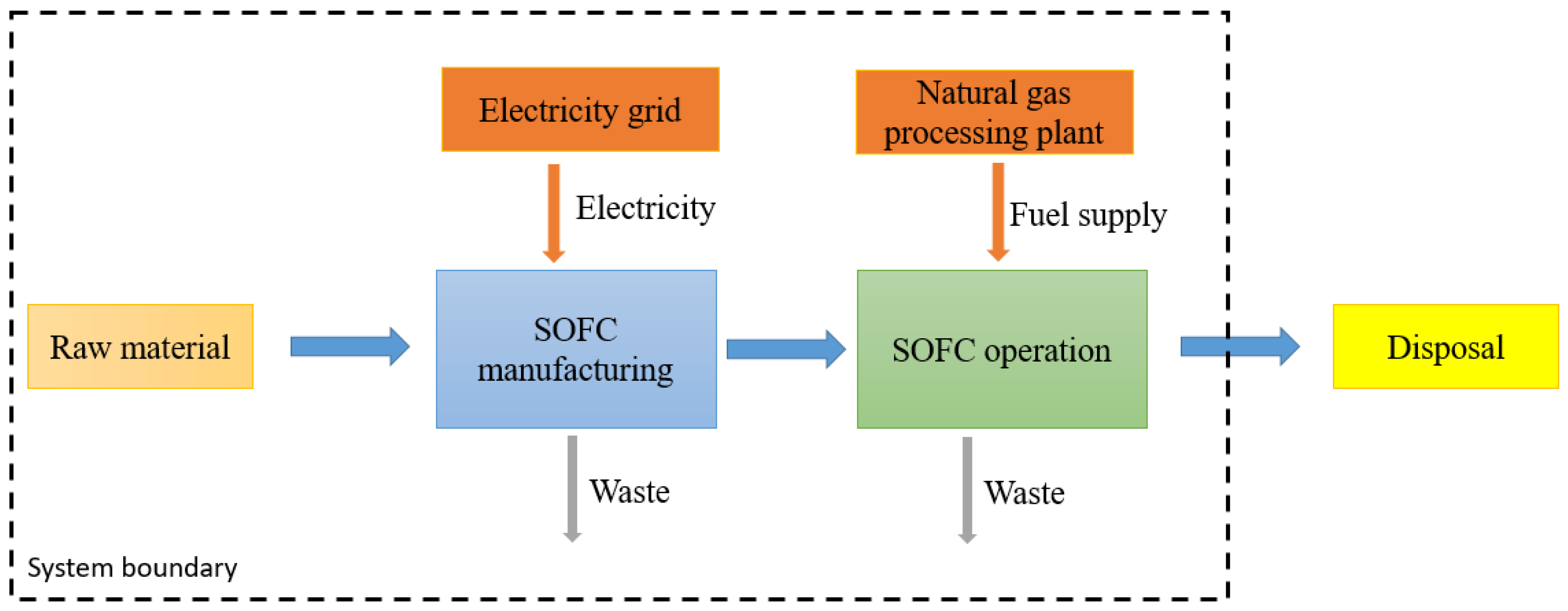

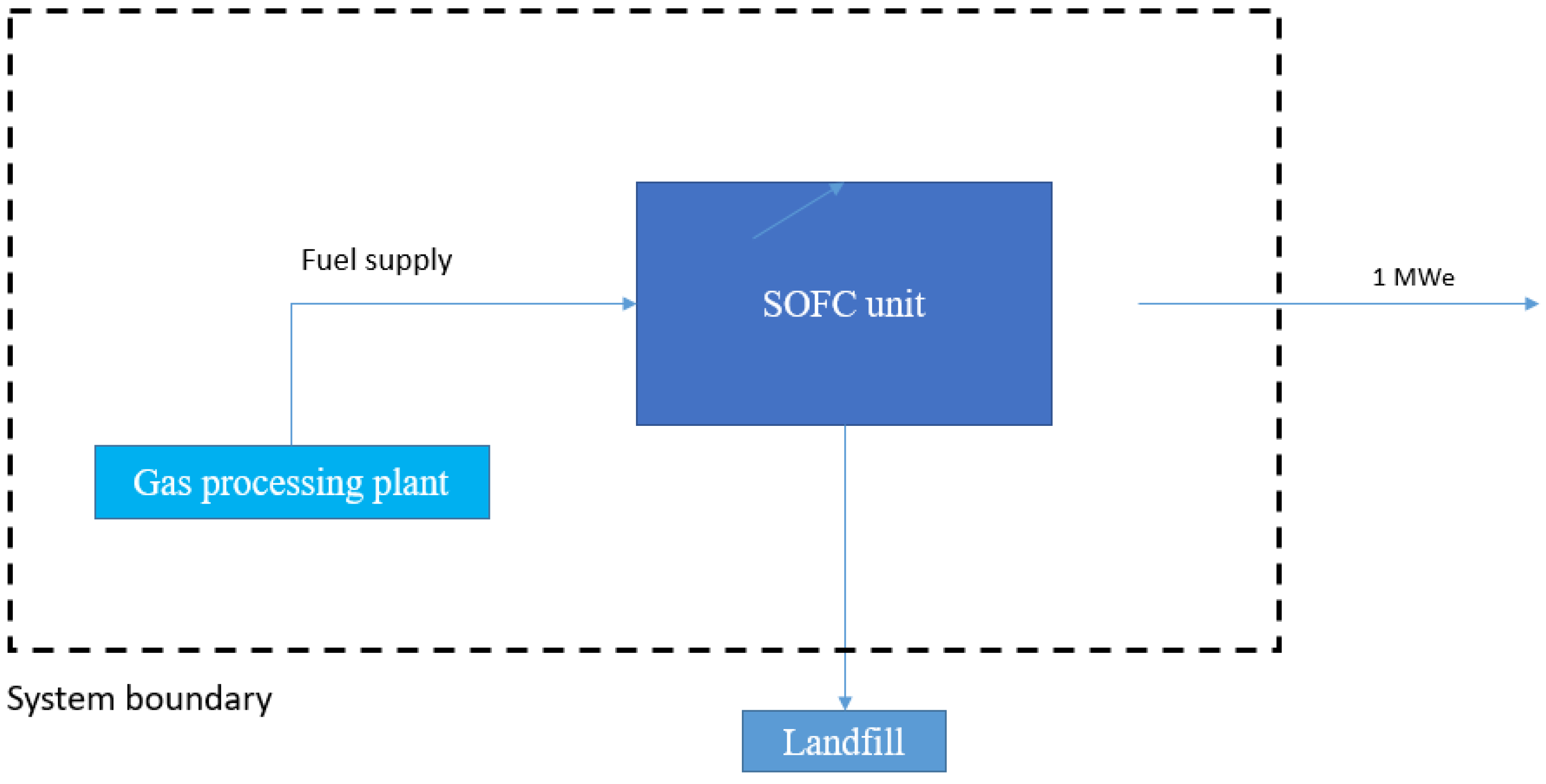
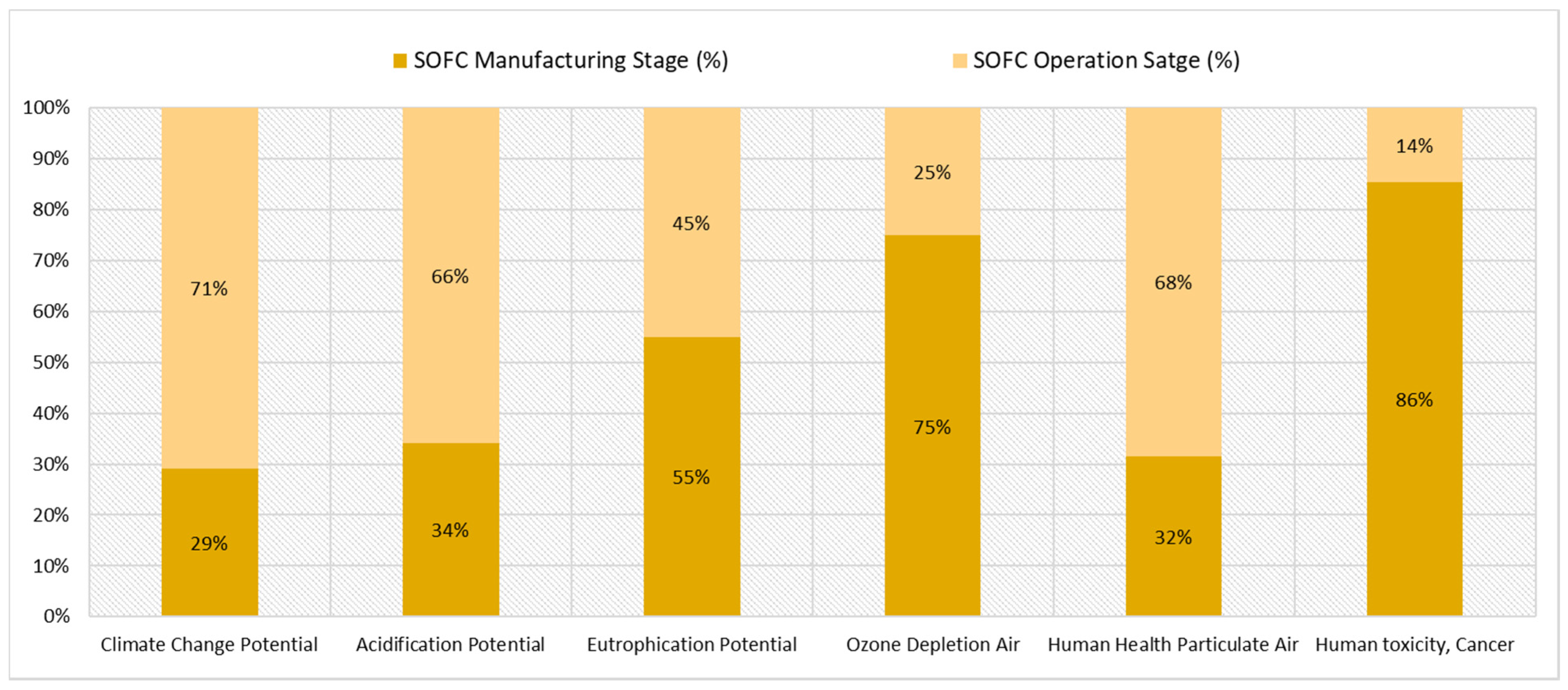

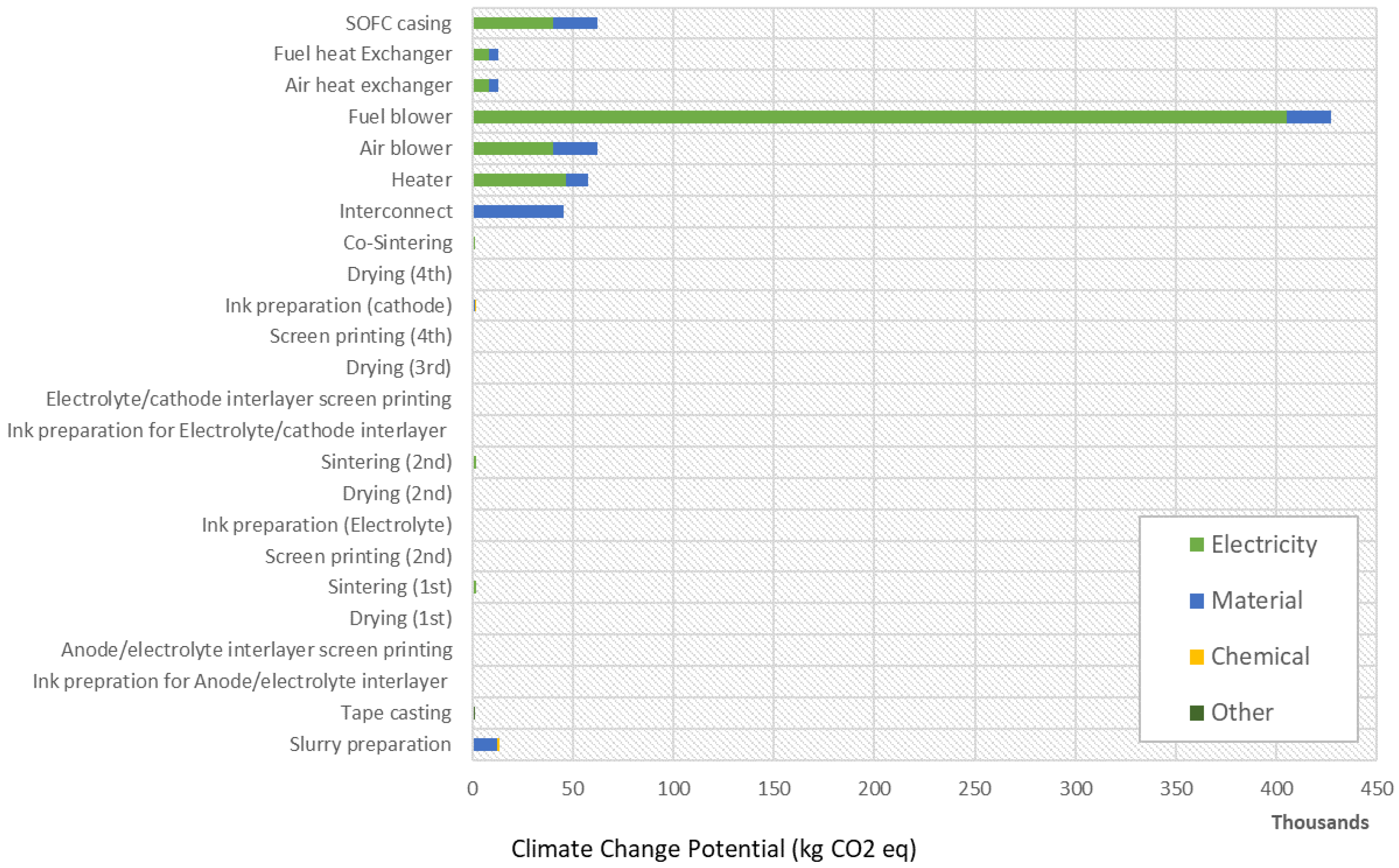
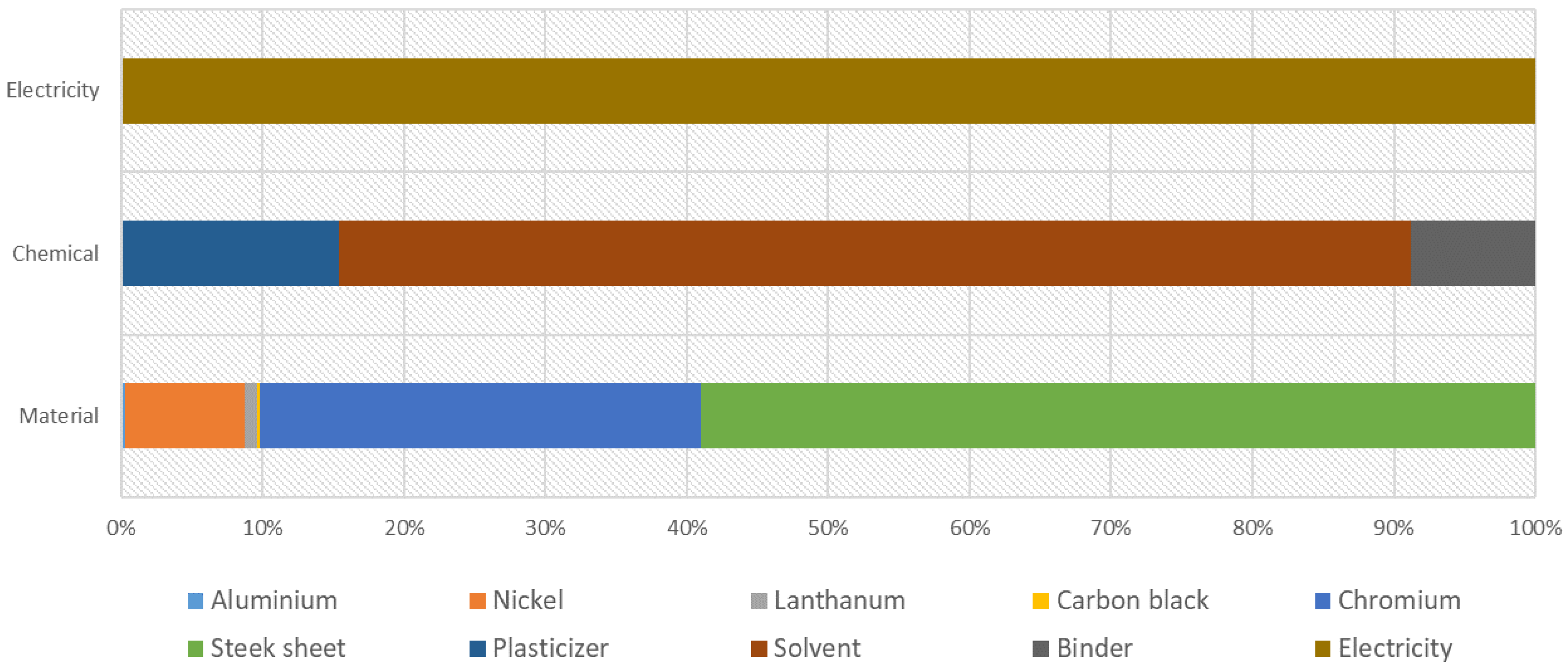
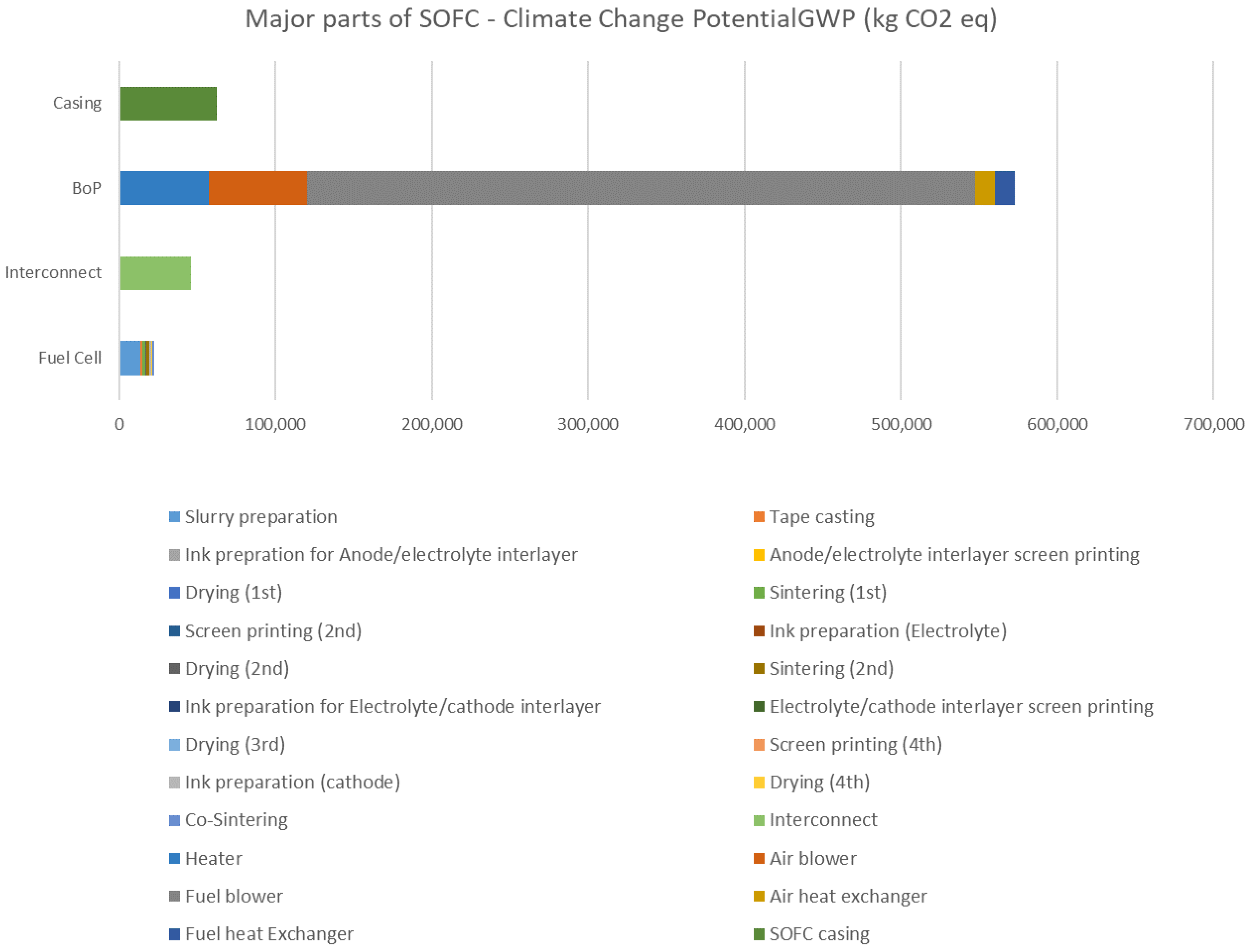

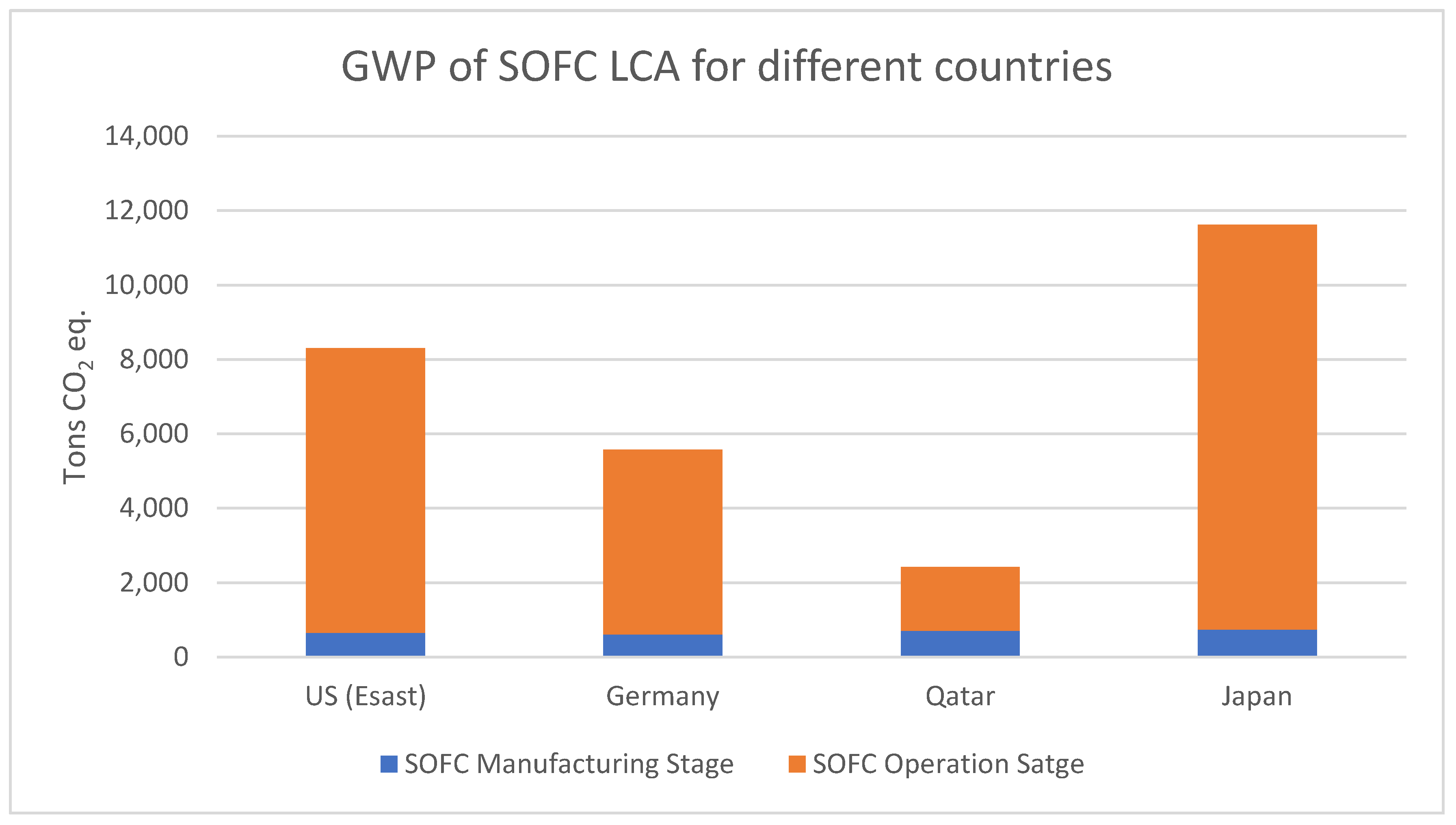
| Material Description | Material Weight (Kg/MW) |
|---|---|
| Anode (Ni 70% wt) | 1116.00 |
| Anode (Alumina 30% wt) | 332.00 |
| Electrolyte (Alumina) | 39.00 |
| Cathode (LSM) | 78.00 |
| Anode/electrolyte interlayer (NiO 50% vol) | 20.00 |
| Anode/electrolyte interlayer (Alumina 50% vol) | 20.00 |
| Electrolyte/cathode interlayer (LSM 50% vol) | 20.00 |
| Electrolyte/cathode interlayer (Alumina 50% vol) | 20.00 |
| Process Type | Chemical Description | Material Weight (Kg/MW) |
|---|---|---|
| Anode Slurry preparation | Plasticizer (Sanitizer) | 132.00 |
| Butvar-76 (binder) | 131.70 | |
| n-Butyl acetate (solvent) | 394.80 | |
| Tape casting | Carbone black (pore former) | 87.60 |
| Electrolyte ink preparation | Butvar-76 (binder) | 3.40 |
| n-Butyl acetate (solvent) | 10.15 | |
| Anode/electrolyte interlayer ink | Methocel A4M (binder) | 22.32 |
| 2-Butoxyethanol (solvent) | 12.60 | |
| Electrolyte/cathode interlayer ink | Methocel A4M (binder) | 22.32 |
| 2-Butoxyethanol (solvent) | 12.60 | |
| Cathode ink preparation | Methocel A4M (binder) | 44.40 |
| 2-Butoxyethanol (solvent) | 25.32 |
| Process Description | Energy Input (MJ/MW) |
|---|---|
| Anode slurry preparation | 40 |
| Anode tape casting | 30 |
| Anode/electrolyte interlayer ink | 70 |
| Anode/electrolyte interlayer screen printing | 60 |
| Drying | 1710 |
| Sintering | 10,530 |
| Electrolyte ink preparation | 140 |
| Screen printing | 130 |
| Drying | 1710 |
| Electrolyte/cathode interlayer ink | 70 |
| Electrolyte/cathode interlayer screen printing | 60 |
| Drying | 1710 |
| Cathode ink preparation | 150 |
| Screen printing | 130 |
| Drying | 1710 |
| Co-Sintering | 8600 |
| Metal forming (for interconnect) | 430 |
| Description | Material Type | Material Weight (Kg/MW) | Energy Input (MJ/MW) |
|---|---|---|---|
| Air blower | Steel | 10,000.00 | 235,200 |
| Fuel blower | Steel | 10,000.00 | 2,355,200 |
| Air heat exchanger | Incoloy/Steel | 2000.00 | 49,400 |
| Fuel heat exchanger | Incoloy/Steel | 2000.00 | 49,400 |
| Heater for startup | Steel | 5000.00 | 270,600 |
| Casing | Steel | 10,000.00 | 235,200 |
| Waste Output (Type) | Quantity (kg/MW) |
|---|---|
| CO2 (air emissions) | 432 |
| n-Butyl acetate (evaporated solvent) | 444 |
| 2-Butoxyethanol (evaporated solvent) | 55 |
| Indicator | Impact Category | Scale | Characterization Factor |
|---|---|---|---|
| CO2 | GWP | Global | CO2 equivalent |
| CH4 | |||
| N2O | |||
| SOx | AP | Regional | SO2 equivalent |
| NOx | Local | ||
| NO | EP | Local | N equivalent |
| NO2 | |||
| CFCs | ODP | Global | CFC 11 equivalent |
| HCFCs | |||
| PM10 | HHPM | Regional | PM2.5 equivalent |
| PM2.5 | Local | ||
| LC50 | HTP | Regional | CTUh |
| Local |
| SOFC Phase | GWP | AP | EP | ODP | HHPM | HTP |
|---|---|---|---|---|---|---|
| Manufacturing | 703,755 | 2000 | 77 | 4.38 × 10−8 | 103 | 3.51 × 10−4 |
| Operation | 1,712,000 | 3848 | 63 | 1.46 × 10−8 | 223 | 5.94 × 10−5 |
| Total | 2,415,755 | 5848 | 141 | 5.84 × 10−8 | 326.33 | 4.10 × 10−4 |
Publisher’s Note: MDPI stays neutral with regard to jurisdictional claims in published maps and institutional affiliations. |
© 2021 by the authors. Licensee MDPI, Basel, Switzerland. This article is an open access article distributed under the terms and conditions of the Creative Commons Attribution (CC BY) license (https://creativecommons.org/licenses/by/4.0/).
Share and Cite
Al-Khori, K.; Al-Ghamdi, S.G.; Boulfrad, S.; Koç, M. Life Cycle Assessment for Integration of Solid Oxide Fuel Cells into Gas Processing Operations. Energies 2021, 14, 4668. https://doi.org/10.3390/en14154668
Al-Khori K, Al-Ghamdi SG, Boulfrad S, Koç M. Life Cycle Assessment for Integration of Solid Oxide Fuel Cells into Gas Processing Operations. Energies. 2021; 14(15):4668. https://doi.org/10.3390/en14154668
Chicago/Turabian StyleAl-Khori, Khalid, Sami G. Al-Ghamdi, Samir Boulfrad, and Muammer Koç. 2021. "Life Cycle Assessment for Integration of Solid Oxide Fuel Cells into Gas Processing Operations" Energies 14, no. 15: 4668. https://doi.org/10.3390/en14154668
APA StyleAl-Khori, K., Al-Ghamdi, S. G., Boulfrad, S., & Koç, M. (2021). Life Cycle Assessment for Integration of Solid Oxide Fuel Cells into Gas Processing Operations. Energies, 14(15), 4668. https://doi.org/10.3390/en14154668







